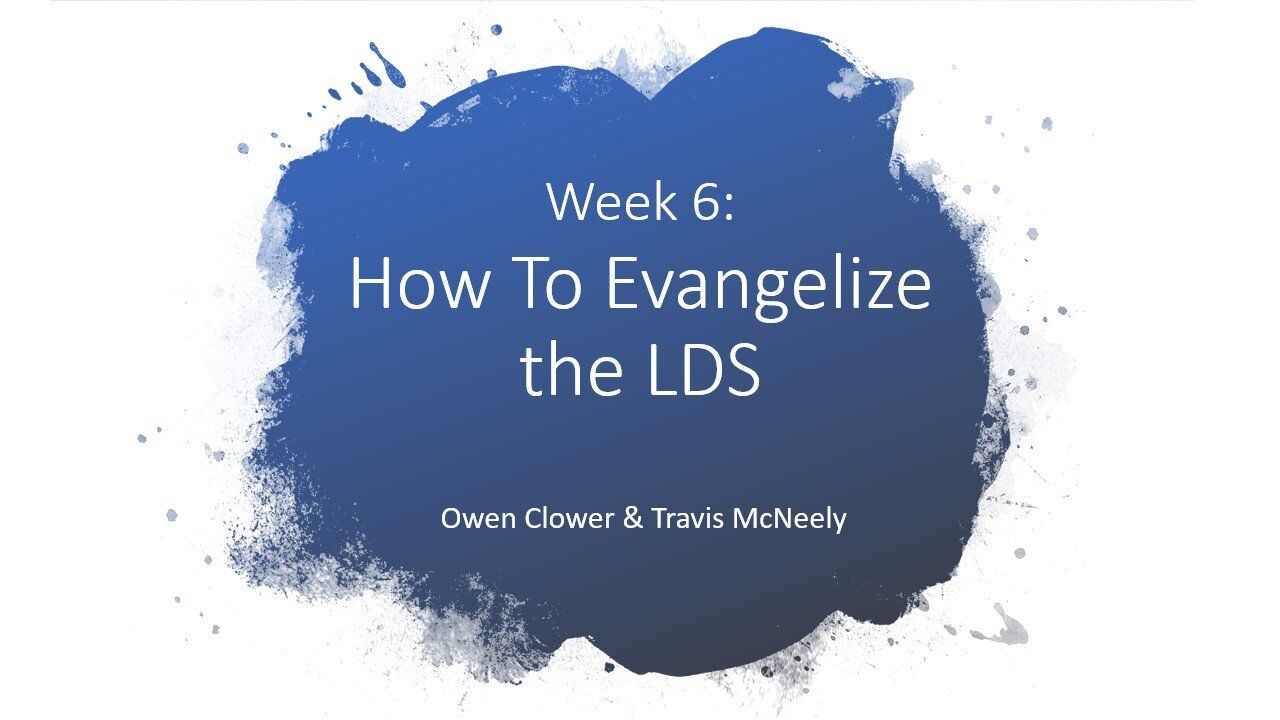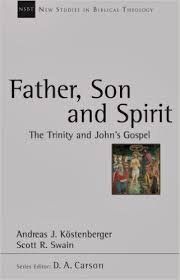In this volume, Köstenberger and Swain rely heavily upon the authority of the Scriptures, with the Gospel of John as the strongest case-maker for Trinitarian theology. Rather than relying on the authority of fourth-century theologians to interpret Scriptures, the authors use the Scriptures to put “pressure” on the discussions that take place after the New Testament is written in regards to the Trinity (21). John’s gospel does reveal all three Persons of the Godhead: Father, Son, and Spirit, and in so doing displays the mutual interaction within the Godhead, leading to what the authors point out as “the trinitarian mission theology” produced from the Trinity (chapter 9). In writing this work, Köstenberger and Swain claim that many fine studies have taken place in this field of theology, but “none that summarizes and synthesizes what John has to say about God as Father, Son, and Holy Spirit” (20). The qualifications of both authors can give confidence to the reader of this works reliability: Köstenberger is a leading scholar in Johannine studies and Swain is a systematic theologian. What this volume brings to the discussion is a paradigm for Trinitarian theology, where one can expect to know the nature, function, and mission of the Trinity from John’s perspective. It also provides biblical foundations for the claims made, and after having made proofs to those claims, there is an empowering application for what Trinitarian theology means for missiology and the mission of God’s people in the world today.
Book Review: Father, Son, and Spirit: The Trinity in John's Gospel by Andreas Köstenberger and Scott Swain

Summary
The author’s do not necessarily state their thesis, but it is obvious they are laboring to summarize and synthesize the Scriptures teaching on the Trinity. In order to prove this, the volume is structured in three major parts: Historical context, Biblical Foundations, and Theological Reflections (7-8).In regards to the Historical Context of the gospel of John, the authors investigate the context it was written in and share the views of other scholars throughout the centuries (27-33). An example of this is their engagement with Bauckham’s thesis on the authorship of John’s Gospel, whether or not it was John the Elder or John the apostle (29-31). The authors respond with a set of eight reasons why they disagree with the research and how Scripture favors their own view of John the apostle as the author (31-2). Following a discussion on authorship comes a section on the occasion of writing during the Second Temple period of Judaism (33), and then a comparison of John’s portrayal of Jesus in light of Jewish monotheism (34). The authors state how the early church viewed Jesus, “ . . . directly with the one God of Israel’ and included ‘Jesus in the unique identity of this one God’” (36). This subsequently would have revolutionary implications for understanding Jesus, Jewish monotheism, Jesus’ pre-existence (40), and the entire Old Testament narrative from creation to Christ (35-6). John’s prologue sets the stage for the entire Gospel to help the readers believe in Jesus as the sent Son of the Father and His inclusion in the divine identity, thus “redefining Jewish monotheism as Christological monotheism” (43-4).The second part of this volume concerns the Biblical Foundations of trinitarian theology (47-107). In this section, there is a systemic and narrative formulated outline to how the authors organize the following argument for trinitarian theology. First, they deal with the Greek word theos (Chap. 2), and how it is used in the text, the Father as God (Chap. 3), the Son (Chap. 4), the Spirit (Chap. 5). But each time they engage in these four sections, there is a template for their approach: beginning with the prologue of John’s Gospel (1:1-18), followed by the Book of Signs (1:19-12:50), then the Book of Glory (13-21), and lastly a summary of the chapter. After the authors have gone through the arguments supporting each Person of the Trinity in John’s Gospel, they do a summary and synthesis in chapter 6.The third part of this volume concerns Theological Reflections from what has been presented in the previous two parts (111-86). This is primarily the application of the knowledge organized from the whole volume, which provides a lot of exciting material in regards to the implications of trinitarian theology. First, the authors present Jesus’ filial identity; they do this to give readers an over-arching perspective to orient themselves as they read through the Gospel account—as opposed to taking this identity and surveying the entire Gospel at every specific occurrence (111). In essence, they are trying to develop a framework to view Christology in the Gospel. The authors’ claim is, “when it comes to understanding Jesus’ identity and mission (‘Christology’), John urges us to perceive Jesus’ identity and mission in a trinitarian light. John’s Christology is a trinitarian Christology” (111).Further reflection leads to explaining the connection between the Son and the Spirit (135). The authors begin this chapter by pointing out a complex yet consistent pattern shaping the rest of the discussion in the chapter. “The Spirit descends from the Father to rest and remain upon the Son so that, through the Son, he may come to rest and remain on Jesus’ disciples as well” (136). Two steps trace this pattern: the first is how John presents the role of the Spirit in Jesus’ ministry from his baptism and through the Book of Signs; the second is how the Spirit relates to Jesus’ disciples in the Book of Glory (136). In short, this chapter explains to the reader not only the relationship between Jesus and the Spirit but also further expounds on the identity of the Spirit flowing through the Son upon the disciples (148). This is vital to understand the role of believers today because the Spirit has come in order to continue the mission of the Father that was given to the Son so that through the church they might reach the world (148). This leads to the next chapter towards a trinitarian mission theology (149).Jesus sent the disciples as the Father sent Him into the world (20:21) and by doing this there is an imitation of the divine mission (149). The author’s present a dual thesis concerning this claim:
(1) John’s mission theology is an integral part of his presentation of Father, Son, and Spirit; and (2) rather than John’s mission theology being a function of his trinitarian theology, the converse is in fact the case: John’s presentation of Father, Son, and Spirit is a function of his mission theology (149).
From this dual thesis comes the identity of the people of God, the church on mission as God is on mission. The church’s identity being transformed by God’s mission is crucial to the gospel message, because from this identity God’s love is spread to the world (John 3:16). For the rest of the chapter, the author’s give proofs for their thesis (sub-sections: God (theos); The Father; The Son; The Spirit) and the culmination of their proofs (sub-sections: The three persons of the Godhead united in one mission; The Trinity and the church’s mission) results in understanding the innate truth of John’s trinitarian mission theology (149-64). This thesis is not merely an intellectual exercise for seminarians and scholars, but it has relevant implications for the church concerning the why and how to fulfill the mission of God in their daily lives. There are other items of reflection in the volume, but this review does not have space to cover the implications of all of them.
Critical Evaluation
This volume has many strong points with few weaknesses, if any, in regards to the presentation of the material on this subject. For a thorough walk-through of the gospel of John’s structure and teaching on the Trinity, one find’s a great resource in this volume for teaching on this subject. The authors handle the material in a way that is helpful and systematic, which points to the pedigree of Swain (the co-author) a systematic theologian. As noted in the summary, they cover, in the following order, the use of the terms, God, Father, Son, and Spirit, one-by-one. It is notable that not only is it well organized with the sub-headings outlining John’s Gospel (Prologue, Book of Glory, and Book of Signs), but also it is succinct and assiduous over such a seemingly paradoxical subject. The authors do a great job focusing on the material at hand, by not getting lost in what other theologians of church history have to say, but by solely focusing on the Gospel of John itself and what it brings to the discussion. Scripture is highly elevated in this volume as the authority on trinitarian theology. Something that would be easy to do for a novice or young seminarian on this subject would be to make every reference possible and disclose all the information possible on the subject. But the authors in this volume refuse to exhaust the entire subject of trinitarian theology. They hardly quote Scripture, unless necessary, but have most references in parenthesis. Also they do not use many cross-references into other parts of Scripture, which would be tempting to do for someone without much experience on the subject. In regards to any negative critique, there is very little in this review. It is in regards to the use of terms in the transition between chapters two and three (58-60). The authors are writing about the term theos and how it can refer to all three parts of the Godhead at different points in the gospel of John. The semantics have to do precisely with how the authors focus mostly on the Father in reference to the term theos at the neglect of mentioning it equally with the two other Persons of the Trinity: the Son and Spirit. If God is one, should not His other Persons disclosed in John’s Gospel be related equally to the divine essence? However, as previously mentioned this might be too technical of a critique and easily cleared up by the authors. They may argue that the negative critique is incorrect based on the subordination present within the Godhead and therefore justifiable to mention the Father more in relation to the term theos .
Significance and Usefulness
The significance this volume brings to biblical theology is a survey of the Trinity in the Gospel of John, which already has a plethora of allusions and anti-types to Old Testament types. This volume helps the reader to understand the Trinity in regards to salvation-history and to see the fulfillment of God’s sent Son and the new covenant established by Him and sealed by the Spirit of God. This is seen in the mission of God expressed by the nature of the Triune-God. This brings the review to how it is useful for missions and theology today. When the authors come to a review of trinitarian mission theology, they illustrate the way in which the Triune-God acts. The Father sent the Son, and the Son reveals the Father; after the Son claims what is His from the Father, He then sends them out on mission, but not without the “Helping Presence” of the Holy Spirit. Father sends the Son, then the Father and Son send the Spirit, as a result, the Spirit of God enables the people of God to be sent to do the mission of the Triune-God. This section of the book is inspiring when it comes to acting out the mission of God in and through the life of the local church by the Spirit’s empowerment.
Points of Interests
- On page 48 the function of the prologue (John 1:1-18) is to address two critical issues: (1) the relationship between God and the Word (Jesus) and (2) the possibility for God to have a close relationship with human beings. This helps to give a framework for the entire Gospel account.
- On page 42, the interpretation of Isaiah 55:11 amazed me, because I had never heard of this verse and John 1:1 being connected. I always thought it referred to the preaching of God’s word, but rather it was about Jesus fulfilling God’s purposes.
- On page 63, the use of “Father” language in John’s gospel has necessary cultural contextualization that may help a reader to understand the gravity of the role of the Father. Not only in the Godhead, but also in the life of the community. Background information like this aids interpretation.
- On page 83, the Synoptic Gospels put Jesus on trial at the end of his ministry, but in John’s Gospel, Jesus on trial throughout his ministry. Consequently, this revealed the hearts of the Jewish people to reject their Messiah as was prophesied in the OT. It is helpful because it reveals the trial motif in the narrative and returns back on the heads of the Jewish leaders, as they are on trial by Jesus, to whether or not they will accept or reject Him.
- On page 85, I had a question about an OT type/allusion concerning Jacob and Jesus. Is the story of Jacob’s ladder a type/allusion when Jesus says something similar in 1:51? Does this denote the fact that Jesus is the means of revelation like Israel was the means of revelation in the OT to the lost world?
- On page 89, According to Jesus, the Son gives life to whom He is pleased to give it. Raising the dead, giving life, and judgment are all divine prerogatives according to the Old Testament and Second Temple literature. Therefore, this helps to secure the deity of Christ from the lips of Jesus, because the He is claiming to have in Himself the divine prerogative of giving life, raising the dead, and executing judgment.
- On page 96, in John 14:15-24 when Jesus says, “yet a little while” a number of times in reference to His return. I thought it was referencing the Son’s resurrection, but it was, in fact, referencing the sending of the Spirit of God, this was new to me.
- On page 171-2, Trinitarian theology and missiology are inextricably connected: “the triune God is characteristically himself in his saving missions because the reliable revelation of his true identity is internal to those saving missions.”
Conclusion In closing, this volume is a superb tool for the pastor, layperson, or seminary student, seeking to further understand who the Triune-God is. The revolutionary implications of the Triune-God displayed particularly here in John’s Gospel can bring a clearer understanding of who God is and how he works, and can bring glory to God, by fulfilling the mission he has set out to do. First and foremost through the Son’s sacrifice but now in and through Christians who love him and obey his commandments. Trinitarian mission has its end in trinitarian doxology and this volume will not only inform, but also inspire others to take up the mission of God for the glory of the Triune God. [contact-form][contact-field label='Name' type='name' required='1'/][contact-field label='Email' type='email' required='1'/][contact-field label='Website' type='url'/][contact-field label='Comment' type='textarea' required='1'/][/contact-form]
Want To Book Me for Your Event or Conference?
Fill out the form below and we'll be in touch!
Book Travis McNeely
We will get back to you as soon as possible
Please try again later
More posts like this...





